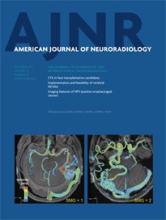Abstract
BACKGROUND AND PURPOSE: Our aim was to investigate the disintegration of the geniculocalcarine tract by using DTI-derived parameters in cases of unilateral occipital or temporal-occipital ischemic stroke with geniculocalcarine tract involvement and to determine whether geniculocalcarine tract fibers affected by infarction and unaffected ipsilateral geniculocalcarine tract fibers have different disintegration processes.
MATERIALS AND METHODS: Seventy-one patients underwent routine MR imaging and DTI of the brain. Fractional anisotropy and mean diffusivity of the geniculocalcarine tract fibers affected by infarction, ipsilateral unaffected GCT fibers, and the contralateral geniculocalcarine tract were measured and compared at 5 different time points (from <1 week to >1 year) poststroke.
RESULTS: The fractional anisotropy of geniculocalcarine tract fibers affected by infarction (0.27 ± 0.06) was lower than that of contralateral GCT fibers (0.49 ± 0.03). The fractional anisotropy of geniculocalcarine tract fibers affected by infarction was not different in the first 3 weeks (P = .306). The mean diffusivity of geniculocalcarine tract fibers affected by infarction (0.53 ± 0.14) was lower than that of the contralateral GCT fibers (0.79 ± 0.07) in the first week but higher after the second week (0.95 ± 0.20 to 0.79 ± 0.06). The mean diffusivity gradually increased until it was equal to the mean diffusivity of CSF after the eighth week (2.43 ± 0.26), at which time both the fractional anisotropy and mean diffusivity values stabilized. The fractional anisotropy (0.50 ± 0.04) and mean diffusivity (0.77 ± 0.06) of the ipsilateral unaffected GCT fibers were similar to those of the contralateral GCT fibers (0.50 ± 0.03 and 0.79 ± 0.07) during the first 3 weeks. The fractional anisotropy then gradually decreased (from 0.42 ± 0.03 to 0.27 ± 0.05), while the mean diffusivity increased (from 0.95 ± 0.09 to 1.35 ± 0.11), though to a lesser degree than in the corresponding geniculocalcarine tract fibers affected by infarction.
CONCLUSIONS: The geniculocalcarine tract fibers affected by infarction and the ipsilateral unaffected GCT fibers showed different disintegration processes. The progressive disintegration of geniculocalcarine tract fibers affected by infarction was stable until the eighth week poststroke. The ipsilateral unaffected GCT fibers began to disintegrate at the fourth week, but to a lesser degree than the geniculocalcarine tract fibers affected by infarction.
ABBREVIATIONS:
- GCT
- geniculocalcarine tract
- CGCT
- contralateral GCT fibers
- FA
- fractional anisotropy
- MD
- mean diffusivity
- UGCT
- ipsilateral unaffected GCT fibers
- © 2013 by American Journal of Neuroradiology












